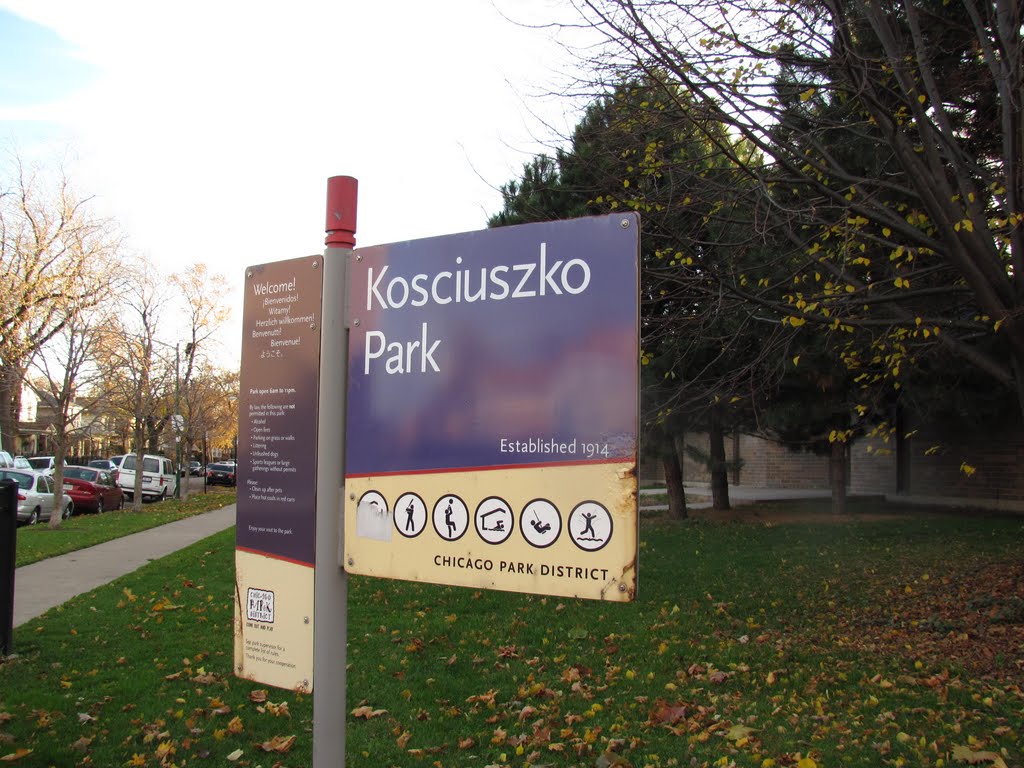
The expansive Kosciuszko Park (pronounced “Ko-shchoosh-coe” in Polish), which is informally referred to by locals as “Koz Park” or “Land of Koz”, is situated between the Chicago neighborhoods of Logan Square and Avondale. It incorporates the Belmont Gardens in its northwest section and is bordered by Central Park Avenue to the east, Pulaski Road to the west, George Street to the north, and Altgeld to the south. This area is an exemplary illustration of a strong regional identity that was formed due to the urban parks created by the civic leaders of the Progressive Era.
On the upper left of Milwaukee Avenue, located between Polonia Triangle (formed by the intersection of Milwaukee, Division and Ashland) and Irving Park Road, was an area called the “Polish Corridor” where Polish people resided. This included the Kosciuszko Park and Avondale areas.
Near the intersection of George Street and Lawndale Avenue, located beside Kosciuszko Park’s boundary with Avondale proper, stands St. Hyacinth Basilica. Established in 1894 as a place for local people to attend to their spiritual needs, the shrine has relics connected to Pope John Paul II, and a holy icon with a sumptuous jeweled crown that was blessed by the pontiff. Other organizations further strengthened the Polish culture in the neighborhood. In 1897, the Polish Franciscan Sisters began constructing a grand complex on Schubert and Hamlin Avenues, featuring St. Joseph Home for the Aged and Crippled, which also served as their motherhouse.

When it was inaugurated in 1898, the city’s first Catholic nursing home was opened. To help support the charitable activities, a vestment workshop was created in 1909 on the second floor, staffed by Polish nuns who had learned their tailoring skills in their homeland. Then in 1928, the Franciscan Sisters increased the size of the complex by constructing the St. Joseph Home of Chicago, a building at 2650 North Ridgeway, designed by the highly esteemed Slupkowski and Piontek architecture firm. This brick building, which has since been demolished, was a grand sight, similar to the Art Deco headquarters of the Polish National Alliance.
Kosciuszko Park had a unique feature in the form of a chapel with a magnificently crafted altar that was devoted to the Black Madonna. Unfortunately, the complex was bought by a developer who eventually destroyed it in order to construct the new St. Joseph Village in 2005. Before the site was redeveloped, the park served as the location of one of Chicago’s first two Polish language Saturday schools. The Tadeusz Kościuszko School of Polish Language, named in remembrance of the park’s heritage, still exists today and educates over 1,000 students.
Kosciuszko Park brought together the many people and subdivisions of the area into one community. It was named after the Polish patriot, Tadeusz Kosciuszko, who was known for constructing West Point and serving in the American Revolution. Kosciuszko was rewarded with U.S. citizenship and the rank of brigadier general for his deeds. The park was dedicated in 1916 and was one of the original parks of the Northwest Park District, founded in 1911.

In keeping with the Progressive Movement of the time, the Northwest Park District had the goal of creating one park in every ten-square-mile zone it supervised. Starting in 1914, they began procuring lands for what would turn into Mozart, Kelyvn, and Kosciuszko Parks, and began to work on them right away. Albert A. Schwartz drafted a Tudor revival-style fieldhouse for Kosciuszko Park, which was enlarged two years after the 22 park districts had been combined into the Chicago Park District in 1936. During the 1980s, a natatorium was added to the complex at the intersection of Diversey and Avers.
Kosciuszko Park soon became a place for community interactions, with people coming together for bonfires, festivals, and other neighborhood celebrations. In the winter, an ice skating rink was installed, and in the summer, there were various sporting events, social dancing, music appreciation hours, and even the city’s “mobile zoo” on occasion.
The Land of Koz is now a colorful area, with gentrification pushing further northwest. Individuals of diverse backgrounds, such as Latin America and Poland, have settled in the area and Kosciuszko Park continues to be a place where the community can congregate. It is a spot for recreation, live performances, and even outdoor movie screenings.

